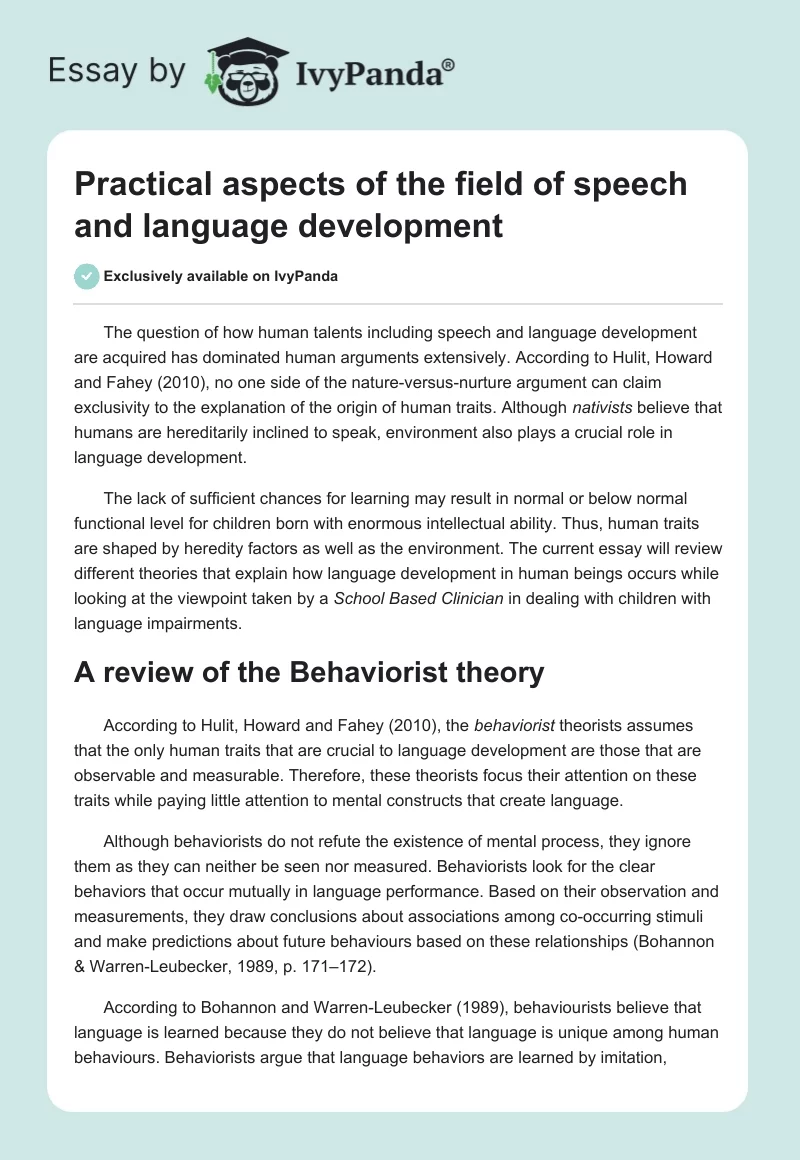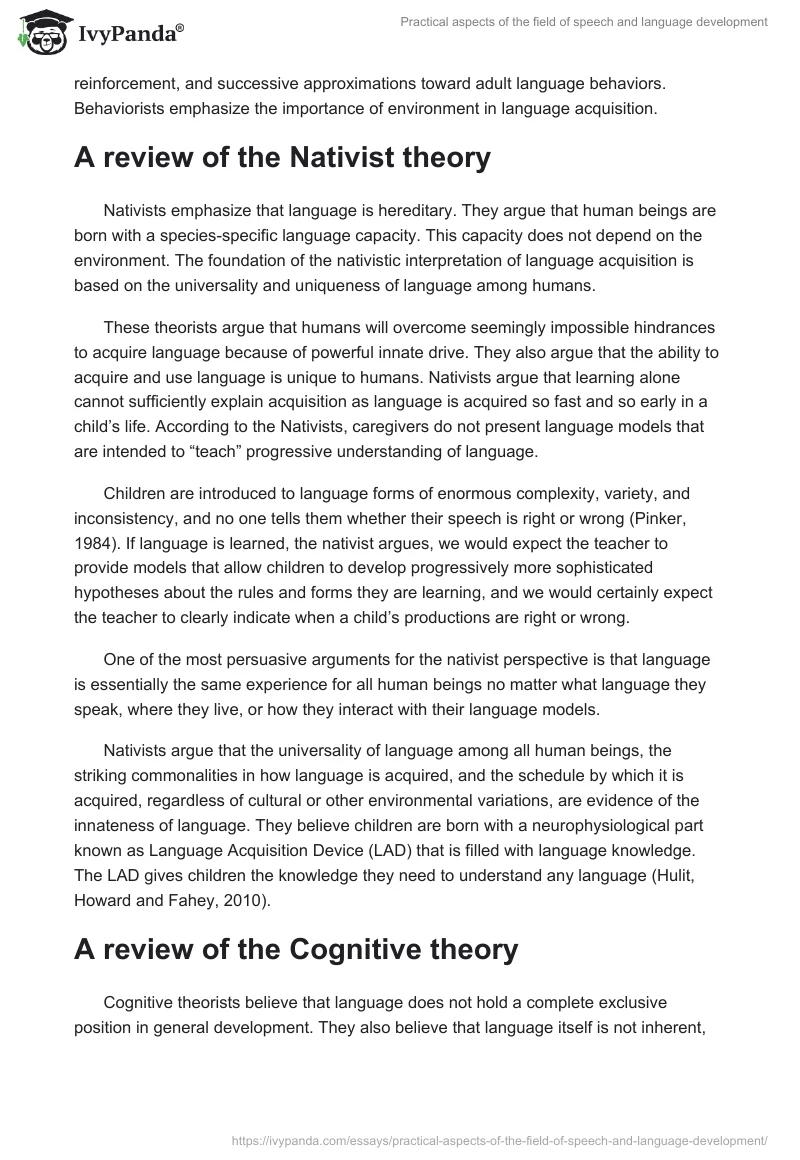The question of how human talents including speech and language development are acquired has dominated human arguments extensively. According to Hulit, Howard and Fahey (2010), no one side of the nature-versus-nurture argument can claim exclusivity to the explanation of the origin of human traits. Although nativists believe that humans are hereditarily inclined to speak, environment also plays a crucial role in language development.
The lack of sufficient chances for learning may result in normal or below normal functional level for children born with enormous intellectual ability. Thus, human traits are shaped by heredity factors as well as the environment. The current essay will review different theories that explain how language development in human beings occurs while looking at the viewpoint taken by a School Based Clinician in dealing with children with language impairments.
A review of the Behaviorist theory
According to Hulit, Howard and Fahey (2010), the behaviorist theorists assumes that the only human traits that are crucial to language development are those that are observable and measurable. Therefore, these theorists focus their attention on these traits while paying little attention to mental constructs that create language.
Although behaviorists do not refute the existence of mental process, they ignore them as they can neither be seen nor measured. Behaviorists look for the clear behaviors that occur mutually in language performance. Based on their observation and measurements, they draw conclusions about associations among co-occurring stimuli and make predictions about future behaviours based on these relationships (Bohannon & Warren-Leubecker, 1989, p. 171–172).
According to Bohannon and Warren-Leubecker (1989), behaviourists believe that language is learned because they do not believe that language is unique among human behaviours. Behaviorists argue that language behaviors are learned by imitation, reinforcement, and successive approximations toward adult language behaviors. Behaviorists emphasize the importance of environment in language acquisition.
A review of the Nativist theory
Nativists emphasize that language is hereditary. They argue that human beings are born with a species-specific language capacity. This capacity does not depend on the environment. The foundation of the nativistic interpretation of language acquisition is based on the universality and uniqueness of language among humans.
These theorists argue that humans will overcome seemingly impossible hindrances to acquire language because of powerful innate drive. They also argue that the ability to acquire and use language is unique to humans. Nativists argue that learning alone cannot sufficiently explain acquisition as language is acquired so fast and so early in a child’s life. According to the Nativists, caregivers do not present language models that are intended to “teach” progressive understanding of language.
Children are introduced to language forms of enormous complexity, variety, and inconsistency, and no one tells them whether their speech is right or wrong (Pinker, 1984). If language is learned, the nativist argues, we would expect the teacher to provide models that allow children to develop progressively more sophisticated hypotheses about the rules and forms they are learning, and we would certainly expect the teacher to clearly indicate when a child’s productions are right or wrong.
One of the most persuasive arguments for the nativist perspective is that language is essentially the same experience for all human beings no matter what language they speak, where they live, or how they interact with their language models.
Nativists argue that the universality of language among all human beings, the striking commonalities in how language is acquired, and the schedule by which it is acquired, regardless of cultural or other environmental variations, are evidence of the innateness of language. They believe children are born with a neurophysiological part known as Language Acquisition Device (LAD) that is filled with language knowledge. The LAD gives children the knowledge they need to understand any language (Hulit, Howard and Fahey, 2010).
A review of the Cognitive theory
Cognitive theorists believe that language does not hold a complete exclusive position in general development. They also believe that language itself is not inherent, even though the cognitive antecedents for language are inherent. They believe that language is not learned.
According to cognitive theorists, language materializes not because children are hereditarily able to produce language and not because learning principles shape language. Language is a product of cognitive organization and development. Language is one of numerous abilities the child develops for reason of intangible representation and manipulation. All of these skills materialize as a result of cognitive maturation.
They surface when there is discrepancy between the child’s existing cognitive structures and new information he is receiving from his environment. These theorists agree that the child’s cognitive abilities differ from the adult’s in terms of how much information is processed and how effectively it is processed. But no matter where a person is in cognitive development, he adds new information into existing cognitive categories, or, if the new information does not fit, he extends, combines, or creates new categories.
The process of language acquisition, according to this view, is not separate from but related to cognitive development; it is one part of, and fully integrated into, cognitive development. Cognitive theorists believe that there exists a relationship, for example, between the child’s understanding that words represent people, places, things, and ideas and the cognitive behavior known as symbolic play.
They believe that there is a connection between understanding that language can be used to get things done and the cognitive behaviours involved in solving problems with tools. Imitation is an important behavior in overall cognitive development just as it is equally an important behavior in speech and language acquisition (Hulit, Howard and Fahey, 2010).
A review of the Information Processing theory
The fundamental claim of information processing theory is that function, not abstract grammar, produces language structure. This outlook implies that a human being processes information just like a computer. They believe that a human being has an information processing system that gathers information from the environment and puts it into symbolic codes that represent words and numbers.
This internal information processing system interprets these symbolic codes, stores them in memory, and permits retrieval of stored information. Language acquisition occurs when a child experiences and gathers language evidence in the productions of her speech and language models and uses that evidence to make fundamental changes within her personal information processing system.
The system is constantly adjusted to make its functions consistent with the language evidence the child is gathering. According to this view, children are not born with an internally wired system for language. Rather, they are born with a potential for all kinds of connections between symbols and the things and ideas symbols can represent. Based on their experiences, some connections are firmly established because they are repeated over and over again.
Other possible connections eventually fade away because children do not experience the evidence to activate them. Children internalize language and the connections between language symbols and the things and ideas they represent because there is a constant inpouring of language evidence. Information processing theory suggests that the processing patterns responsible for the acquisition of language are parallel rather than serial. Parallel patterns occur at many levels at the same time (Hulit, Howard and Fahey, 2010).
A review of the Social Interactionist theory
According to the social interactionist interpretation, both hereditary and environmental factors are vital in language acquisition. These theorists believe that the contact of a child with his parents or other caregivers is a vital facet of language acquisition and development.
These theories assume that language acquisition is a product of children’s early social interactions with the important people in their life. They point out that children communicate and interact socially with other people before they are able to produce language forms. They believe that language develops as a natural consequence of these interactions.
The effort by children to talk and meet with people makes their parents and other caregivers to give them the language suitable for these interactions. As language development occurs in children, their communicative and social skills increase, enabling more mature and refined interactions. The intent to communicate leads the child to interact with people who can respond to his intent.
The intention shapes his early efforts to communicate, regardless of how rudimentary or unrefined these attempts may be. The identification of the child’s aim and related communicative effort compels the caregiver not only to meet the goal but to offer a suitable language model to support the intention. The interactionist view emphasizes the significance of contact between the child and his caregiver(s) (Hulit, Howard and Fahey, 2010).
Viewpoint taken by the Interviewee in his work with children with language impairments
The interviewee takes the social interactionist approach in his work. This is because he believes that the interaction of the child with his parents and other care givers is important for the child to acquire and develop language. In the interview, he emphasizes the need for schools to tailor their teaching methodologies to the needs of the children with language impairments. According to the interviewee, the school has to offer a conducive environment that will enable the child to develop language.
This might involve changing the teaching method from language based to the most suitable method if need be. The work of the interviewee involves meeting with children and talking about their goals and strengths. Although the interviewee believes that each person is endowed with innate survival instincts that come into play in the face of danger or trauma, he also believes that children with language impairement can be taught.
The belief in his work is a clear indication that he approaches his work like a social interactionist. According to the social interactionists, both hereditary and environmental factors are essential in the process of language acquisition. By dedicating his time to talk to the children, he believes that he might help them to learn and acquire education.
Personal perspective most suitable for dealing with children with language impairment
From a personal outlook, the social interactionist approach is the most suitable. This is because it draws from both genetic and environmental factors. This perspective believes that language can be learnt through interaction with parents and caregivers. For children having learning impairment, social interaction is very crucial in building their self esteem and helping them to focus on their strengths rather than on their weakness. The social interactionist perspective is the most suitable approach as it calls for the involvement of parents, teachers, social workers, and other caregivers in helping a child develop language skills.
References
Bohannon, J., & Warren-Leubecker, A. (1989). Theoretical approaches to language acquisition. In J. Berko- Gleason (Ed.), The development of language (pp. 167–213). Columbus, OH: Merrill/Prentice Hall.
Hulit, L. M., Howard, M. R., & Fahey, K.R. (2010). Born to Talk: An Introduction to Speech and Language Development, 5th ed.Upper Sadle River, New Jersey: Pearson Education,Inc.
Pinker, S. (1984). Language, learnability and language development. Cambridge, MA: Harvard University Press.


